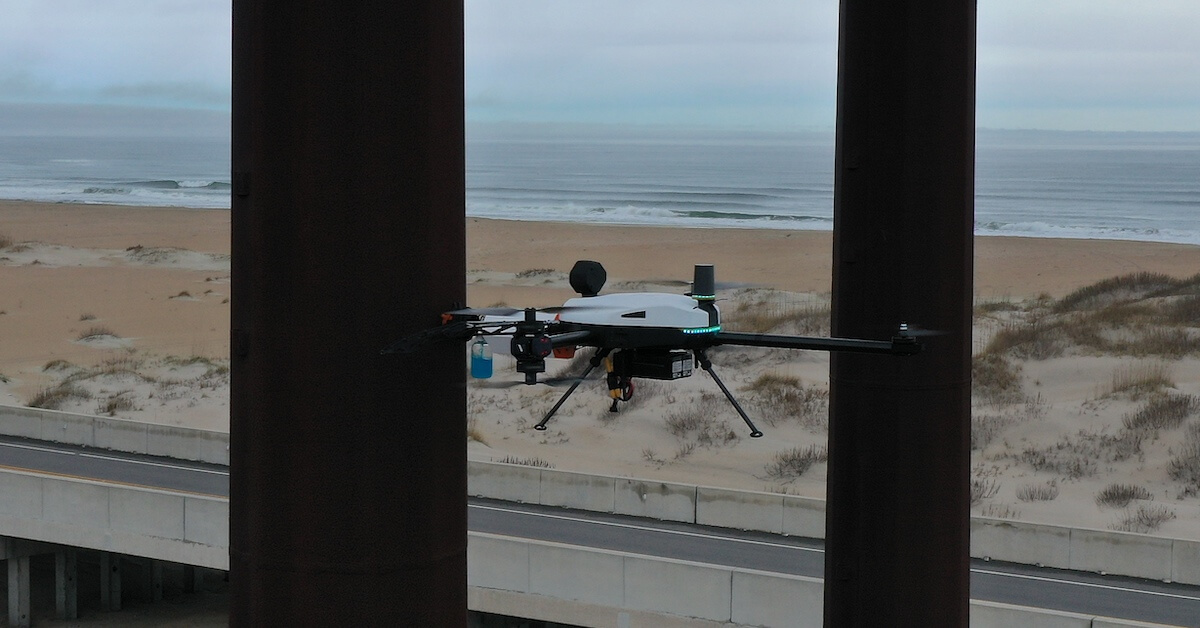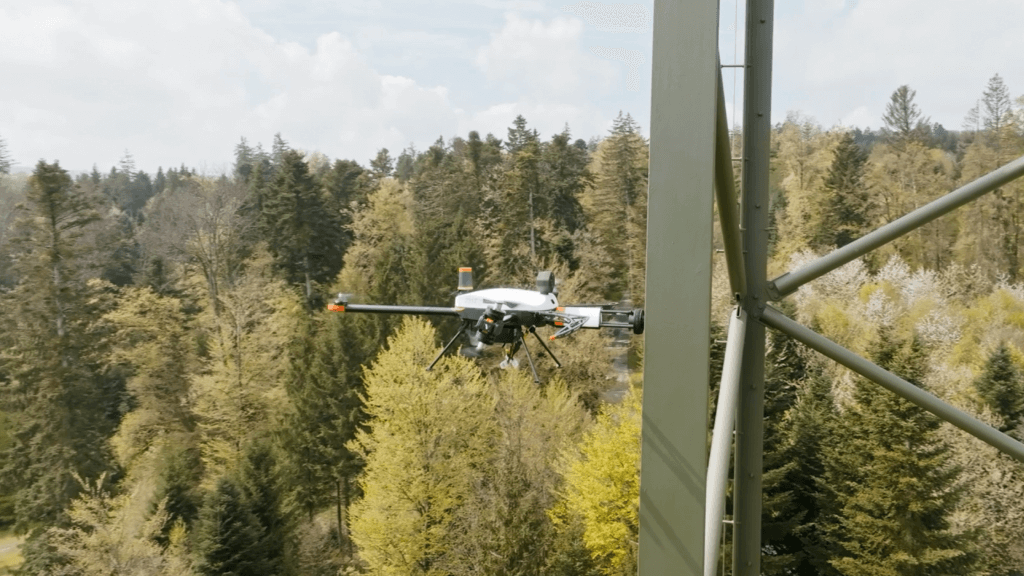
A message, that took three months to travel between Europe and India two centuries ago, now buzzes on your phone in seconds. A cross-continental dialogue, once relying on miles of cords and cables, can now be made wirelessly from mountaintops and faraway forests.
Cell towers power 24/7 global connectivity to the extent that the smallest telecom failures immediately cause public clamor. As mobile data traffic volumes continue to grow and new edge devices join the networks, telecoms need to construct new cell towers and upgrade existing ones. That means inspections and maintenance will be high on the agenda. In this post, we explain how drones help with cell tower maintenance.
To ensure that telecom infrastructure can support critical operations and meet customer demands, government agencies mandate regular maintenance. This means regular assessments of all cell tower components for signs of wear, damage, corrosion, and malfunctions. Specifically, telecom businesses need to examine antennas and lines, remove rust, check plumb and tension, replace UPS batteries, and test the lightning protection system (LPS).
The TANSI/TIA-222-G standard specifies the following assessment and maintenance intervals, based on cell tower type:
Aside from being a regulatory requirement, routine cell tower inspections are a top concern for telecom boards. Downtimes cost millions of dollars in customer compensations alone, not to mention potential fines, lost customer base, and general reputation losses.
For instance, AT&T’s recent February outage left at least 76 thousand customers without network service and blocked 92 million calls, further incurring $140 million in compensation costs. Across the globe, Optus’ 2023 outage left 10 million Australians without connection and cost the company around $40 million. Finally, the 2022 Rogers outage in Canada affected 12 million Canadians and cost $70 million in customer refunds.
A lot of the outages can be avoided with preventive maintenance. But traditional cell tower inspection methods require a lot of time, money, and planning.
First, you need to align an inspection schedule with the whole team and plan for a shutdown to avoid exposing personnel to high voltage. Then the inspection crew will have to travel to cell towers — some located in remote mountainous or forested areas.
On site, the team will need rope access, specialized lifting equipment, and protective gear. Climbers might also encounter unexpected challenges like nested birds or vegetation encroachment.
The alternative to the above is using lightweight, maneuverable inspection drones that enable asset data collection at heights.
Drone-assisted inspections bring significant cost, safety, and productivity benefits. Inspectors don’t need to climb high cell towers or risk exposure to residual electricity. As a result, you save money and time on access equipment and downtime — almost $150k for a single inspection.
With extended battery life, long transmission rates, and autonomous flight capabilities, drones can approach remote cell towers and inspect large, operational structures in one go. Such extended inspections do not mean you need to expand your team. The crew size can be as small as one or two members for most missions.
Modern cell tower inspection drones withstand high-voltage environments found near some assets. With robust obstacle avoidance systems, LiDAR sensors, and AI autonomy, they safely operate in GPS-denied areas with electromagnetic interference. Enterprise drones are also protected against moisture and dust, turning them into a reliable solution for emergency flights.
By combining a drone with different payloads — EO/IR cameras, ultrasonic inspection tools, and photogrammetry systems — you can collect rich asset data to make informed decisions on cell tower maintenance and repairs.
Below are five proven use cases of drones for cell tower inspection.
Daily wear, severe weather, and increased load contribute to cell tower degradation. Additionally, operators may install additional equipment, replace structural components, reinforce welds, extend foundations, or rebury cables.
However, many owners fail to update cell tower documentation, leaving as-designed or as-built models as a baseline for maintenance. Such inaccuracies lead to resource misallocation and false estimates of the remaining asset lifespan.
With photogrammetry drones, you can maintain up-to-date cell tower models. Using wide-angle cameras, drones capture hundreds of images from different angles for 2D/3D model development. LiDAR sensors provide extra geo precision and help properly capture asset’s dimensions and right-of-ways.
This way, you can obtain realistic 3D models down to every knot and bolt. Moreover, you can save the flight routes and use them to conduct autonomous inspections, continuously collecting new data and helping you update a cell tower model.
Rakuten Mobile recently launched a drone program to digitize its cell tower portfolio. Historically, the company sent engineers to climb antenna towers and visually inspect the equipment. With drones, Rakuten reduced inspection time, improved safety, and gathered rich data for 3D models of newly constructed mobile stations.
The autonomous UAVs took multi-angle pictures of base stations and their surroundings. All this data was then uploaded to a cloud-based inspection system where Rakuten automatically processed imagery and distributed insights across teams.
Cell towers require a protective coating to resist and delay corrosion, erosion, and material loss. Although there are many options on the market (paint, epoxy, metal), hot-dip galvanization with zinc is the most durable choice when it comes to high-voltage cell sites.
For towers located in mild climates, the applied film thickness must be at least 125 microns. In areas with increased heat, moisture, ice buildup, or chloride ingress, an ideal thickness is 250 microns.
Yet, under environmental impacts, any protective coating wears down: faster in extreme climates, and slower in mild ones. Over time, you might witness peeling, corrosion, cracking, or discoloration. Dry film thickness testing can prevent early degradation through early thinning detection.
Specialized inspection drones like Voliro feature a DFT payload for performing tests on the fly. Our probe has two measurement modes — eddy current or magnetic induction — to measure thickness down to millimeters. With our drone, you can perform DFT measurements right after painting and insulation.
EnerTrans used Voliro with a DFT probe to test the protective coating on a set of 380 kV transmission towers. With just one person curating the mission, the company inspected 10-12 towers per day immediately after painting, with hardly any downtime.

Detailed, close-up inspections verify the structural integrity of each element, from tower foundations and guy anchors to wires, fittings, and antennas. Drones, outfitted with a variety of payloads, can aid with non-destructive testing at heights.
Models with robust RGB cameras can help capture the precise size, location, and orientation of defects not visible to the human eye, but detectable with anomaly detection solutions. SK Telecom automated cell tower inspections by combining drone deployments with AI-powered data analysis. The company deploys drones to capture around 100 photos of one tower and then feeds the data to a custom AI model. Using image recognition technology, the model automatically validates the integrity of bolts and nuts. According to SK Telecom, this process reduced inspection time by 95%.
Specialized NDT probes, in turn, help locate surface and subsurface defects in the earliest stages, far ahead of the optical detection range. Take Voliro’s innovative Pulsed Eddy Current (PEC) probe as an example. Using high-energy pulses with noise cancellation, the payload can assess early-stage corrosion under the insulation in various pipes and walls. The PEC impulses are very permeable, revealing metal loss even beneath 100 mm of insulation — a stellar characteristic for inspecting a variety of telecom assets.
Cell towers suffer from both direct and indirect lightning strikes, especially if they are located at high altitudes and in a thunderstorm-prone area. For instance, in the Swiss Alps, one cell tower is struck by lightning nearly 100 times each year — so often that researchers re-equipped it for lightning studies.
A lightning protection system (LPS) is mandatory for most towers. An LPS diverts flashes to the ground. Yet, the constant high voltage and weather incidents cause malfunctions in LPS or surge protection devices. Failure to inspect and maintain them could lead to melting antennas, destructed transmission equipment, damaged electronic systems, and even fires at right-of-ways.
Drones can streamline LPS inspections, performing both visual and continuity tests. Voliro T, for instance, can be fitted with a unique LPS tester, capable of performing 4-wire measurements on assets up to 250 meters (820 feet) high. The probe boasts a measurement range between 0.001-1000 Ω and has a maximum voltage of 24 V.
Skyspecs used Voliro to test the LPS integrity of 210 wind turbines across Germany and the United States. With just one person managing the gear, the company performed 8-18 asset inspections per day, locating 3-4 previously undiscovered defects. One mission takes no more than 20-30 minutes.

Cell towers located in extreme climates are at risk of flooding, wildfires, and hurricanes. In such cases, loss of connectivity not only affects residents and businesses but also limits rescue efforts. It’s often dangerous to send a rescue team to the site without having good situational awareness.
Engineers can assess the damage and determine a safe and efficient repair strategy by using UAVs as first responders instead. The best enterprise drones have long transmission ranges, navigation in GPS-denied environments, and auto-return modes. Thus, they can help gather data when connectivity is limited. Plus, some commercial models can withstand high voltage – a frequent occurrence at tower sites after thunderstorms.
Verizon is one of the telecom leaders that uses drones to step up its emergency response, particularly in the wake of Hurricane Matthew. The company deployed UAVs to collect 3D imagery and system performance data on their cell sites. With a two-person crew, the drone recorded and livestreamed HD video of water levels and severity of damage. After the drones demonstrated that the site was safe to access, the Verizon team was sent to refuel the generator.
Telecom asset management is a complex, resource-heavy process — and with infrastructure rapidly expanding, telecom companies must seek extra efficiencies where they can. From this standpoint, drones are a smart investment that lowers inspection times, costs, and coordination efforts.
Versatile platforms like Voliro can support a variety of inspection scenarios — from DFT measurement and component inspections to lighting protection system testing. One subscription provides you access to all payloads, software updates, all-cover insurance, spare part replacements, and pilot training. Voliro subscription takes care of mundane tasks so you can focus on what matters most — keeping the world connected.